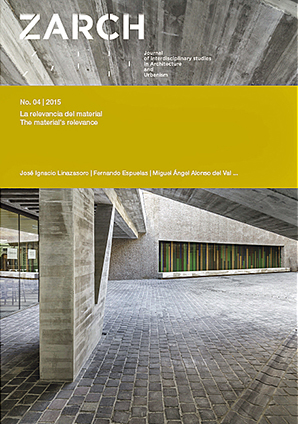Tradition in the architectural thought of Julio Cano Lasso. Tradition as a system
DOI:
https://doi.org/10.26754/ojs_zarch/zarch.201549081Keywords:
Julio Cano Lasso, tradition, modernity, originality, technique, historyAbstract
We start from the idea that the focus on architecture and the thought of Julio Cano Lasso is the mode of transmission and survival of the past in the present, ie; the tradition. This research adopts in Cano a dual form. On one hand, the tradition considered as a continuous flow, maintaining constant structural characteristics and subjected to a selection process immanent that discards what is superfluous and distills only what is valuable. This theoretical statement results in the use of typology as a design method. On the other hand, ,there is tradition inserted into the fractional temporality of personal memory that destroys history as continuity and as immanence, and moves away from the evolutionism and the teleological claims of the previous statement. The latter is revealed in his work by using the reference method. In this paper we deal with analyzing the architect thinking regarding the first conceptual line. We review the writings of Cano and, through the comparison with their documented sources, Ortega y Gasset and Pedro Salinas, and the writings of other authors such as Aldo van Eyck, Igor Stravinsky, Alasdair MacIntyre, T.S. Eliot or Eugenio Trías, we will try to clarify the meaning of tradition as system for the architect, along with other related concepts: art, history, evolution, progress, modernity, originality and eclecticism.
Display downloads
References
BANHAM, Reyner. La Atlántida de hormigón. Nerea. San Sebastián, 1989.
BURCKHARDT, Jacob. Reflexiones sobre la historia universal. Fondo de Cultura Económica. México, 1996.
CANO LASSO, Julio. Julio Cano Lasso. Arquitecto. Xarait Ediciones. Madrid, 1980.
— Conversaciones con un arquitecto del pasado o diálogo de la técnica y el espíritu. Edición del autor. Madrid, 1989.
— Nuestras viejas ciudades. Discurso del académico electo Exmo. Sr. D. Julio Cano Lasso: Leído en el acto de su recepción pública el día 24 de febrero de 1991. Real Academia de Bellas Artes de San Fernando. Madrid, 1991.
— Cano Lasso. 1949-1995. MOPU. Madrid, 1995.
— Estudio Cano Lasso. Electa. Milán, 1996.
CAPITEL, Antón. “Notas sobre la figura de Julio Cano en la arquitectura española”. Arquitectos 123. CSCAE, 1991.
DE LA TORRE DIAZ, Francisco Javier. El modelo de diálogo intercultural de Alasdair Macintyre. Dykinson-Universidad San Pablo CEU. Madrid, 2001.
DIDI-HUBERMAN, Georges. Ante el tiempo. Adriana Hidalgo Editora. Buenos Aires, 2011.
— La imagen superviviente. Historia del arte y tiempo de los fantasmas según Aby Warburg. Abada Editores. Madrid. 2013.
ELIOT, T.S. The Sacred Wood: Essays on Poetry and Criticism. Routledge. Nueva York, 1920.
— After strange gods: a primer of modern heresy. (The Page-Barbour lectures at the University of Virginia, 1933). Faber & Faber, Londres, 1934.
JUNG, Carl Gustav. Obra Completa volumen 9/I: Los arquetipos y lo inconsciente colectivo. Editorial Trotta. Madrid, 2002.
MACINTYRE, Alasdair. After virtue. A Study in Moral Theory. University of Notre Dame Press. Notre Dame, 1981.
— Whose Justice? Which Rationality? University of Notre Dame Press. Notre Dame. 1988.
MARTÍ ARIS, Carlos. Las variaciones de la identidad. Ediciones del Serbal-COAC, Barcelona, 1993.
MARTÍN, Inés; PANCORBO, Luis. “El Madrid de Julio Cano Lasso. De la utopía a la realidad”.
REIA. Universidad Europea de Madrid, 2014, 98-114.
MIRANDA, Antonio. Ni robot ni bufón. Editorial Cátedra. Madrid, 1999.
ORTEGA Y GASSET, José. La rebelión de las masas. Espasa Calpe. Madrid, 1966.
— El espectador (selección). Salvat. Barcelona, 1969.
— Historia como sistema y otros ensayos de filosofía. Alianza. Madrid, 2008.
PEVSNER, Nikolaus. Historia de las tipologías arquitectónicas. Gustavo Gili. Barcelona, 1979.
QUATREMÈRE DE QUINCY, A. C. Cartas a Miranda. Nausicaä. Murcia, 2007.
ROQUETTE RODRÍGUEZ-VILLAMIL, Juan Luis. La arquitectura de Julio Cano Lasso. Tesis Doctoral inédita. Escuela Técnica Superior de Arquitectura. Universidad de Navarra, 2010.
SALINAS, Pedro. Jorge Manrique o tradición y originalidad. Península. Barcelona, 2003.
STRAVINSKY, Igor. Poética musical. Acantilado. Madrid, 2006.
TRÍAS, Eugenio. Lógica del límite. Destino, Barcelona, 1991.
VAN EYCK, Aldo. “El interior del tiempo”. Circo. La cadena de cristal 37. Madrid, 1996.
VARGAS, Mariela Silvana. “La vida después de la vida. El concepto de nachleben en Benjamin y Warburg”. Thémata 49, enero-junio 2014, pp. 317-331.
WINCKELMANN, Johann Joachim. Reflexiones sobre la imitación de las obras griegas en la pintura y la escultura. FCC. Madrid 2007.





